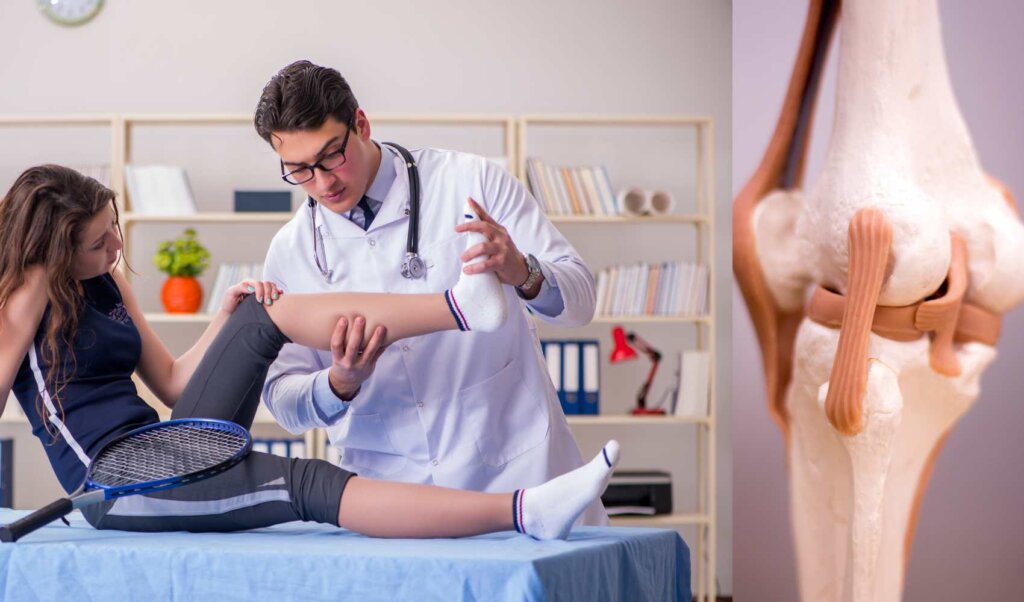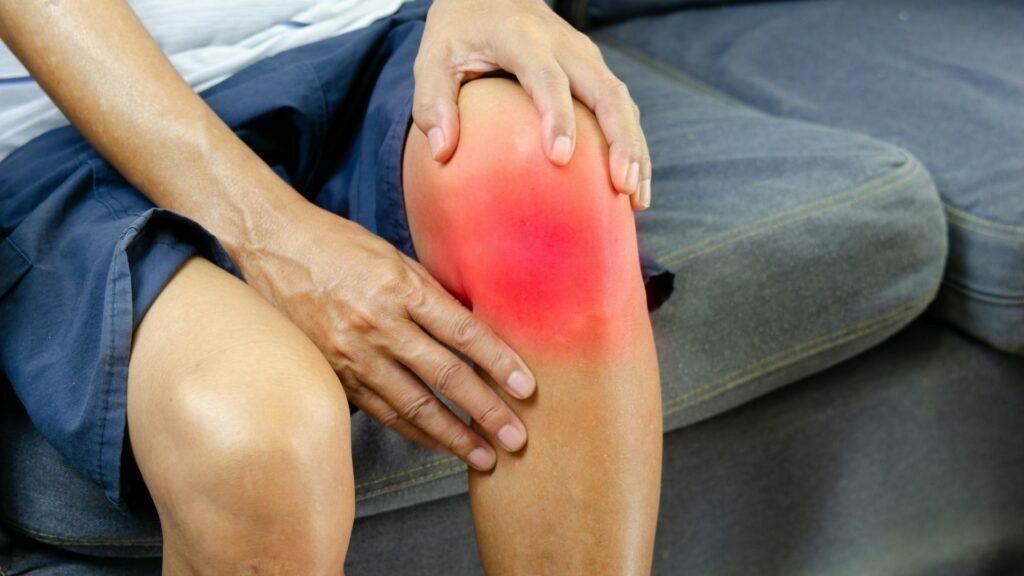About Knee Injuries - Ligaments
Understanding the Anatomy of Knee Ligaments
- The Complexity of the Knee Joint: The knee is an intricate joint consisting of bones, cartilage, and crucially, ligaments. It’s like a well-coordinated system, each part playing its vital role.
- The Ligament Family: Four significant ligaments in the knee ensure stability and facilitate specific movements. They include the Anterior Cruciate Ligament (ACL), Posterior Cruciate Ligament (PCL), Medial Collateral Ligament (MCL), and Lateral Collateral Ligament (LCL).
- ACL and PCL: These siblings work together inside the knee joint, connecting the femur (thigh bone) to the tibia (shin bone). They regulate forward and backward movements and prevent the tibia from sliding out in front of the femur.
- MCL and LCL: These ligaments are the knee’s side guards. The MCL connects the femur to the tibia on the inner side of the knee, while the LCL links the femur to the fibula on the outer side. They control the sideways movements of the knee.
- The Menisci – The Knee’s Shock Absorbers: To add another layer to our understanding of the knee’s anatomy, let’s not forget about the menisci. The knee joint houses two crescent-shaped pads of cartilage known as the medial and lateral menisci. They sit between the femur and the tibia and act as the knee’s shock absorbers.
- Dual Role of the Menisci: Apart from cushioning the knee joint, the menisci also enhance stability by spreading the load of the body’s weight more evenly across the knee joint.
- Medial Meniscus and Lateral Meniscus: The medial meniscus is located on the inner side of the knee, while the lateral meniscus rests on the outer side. They work in unison to reduce friction between the knee bones, allowing smooth and pain-free movement.
Together, these ligaments and menisci form a complex yet fascinating system that enables the knee to function optimally, making actions like jumping, running, or even simple walking possible.
Mechanism of Knee Injuries
Injury to the knee ligaments often occurs during high-impact or dynamic activities where the knee is subjected to significant stress. This can include rapid changes in direction, sudden stops, or direct impact to the knee. Emma’s case is a classic example of how such an injury can occur.
Here’s what happened to Emma:
- Pivot and Change of Direction: Emma was playing soccer, a sport that involves frequent and rapid changes in direction. At one point in the game, she planted her foot firmly on the ground to pivot and change direction.
- Knee Twisting: When Emma’s foot was planted and she attempted to rotate her body, her knee was forced to twist. This twisting motion is a common cause of ligament injuries, as it can stretch the ligaments beyond their normal range.
- Excessive Stress on the ACL: The twisting motion coupled with the force of her body weight moving in a new direction put excessive stress on her anterior cruciate ligament (ACL). This is the ligament that helps to stabilize the knee and prevent it from rotating too far.
- ACL Tear: The stress was too much for the ACL, causing it to partially tear. This is known as a Grade II ACL sprain.
- Immediate Pain and Swelling: Immediately after the injury, Emma experienced severe pain, swelling, and instability in her knee. These are common symptoms of a ligament injury.
This sequence of events highlights the vulnerability of the knee ligaments during high-stress situations. In particular, sports that involve a lot of pivoting and changing direction, such as soccer, basketball, and skiing, can put individuals at a higher risk for these types of injuries. It’s not just athletes who can be affected, though. Even everyday activities that involve awkward movements or falls can result in similar injuries.
Types of Ligament Injuries associated with Knee injuries
- Grade I Sprain: This is a mild injury that slightly stretches the ligament but does not significantly affect the knee’s stability. The ligament remains intact, and the knee joint doesn’t loosen. This type of injury often results in minor pain and swelling.
- Grade II Sprain (Partial Tear): This is a more severe injury where the ligament is partially torn, and it’s often accompanied by noticeable looseness in the knee, indicating a partial loss of function. Emma’s ACL injury fell into this category, where her anterior cruciate ligament was partially ( ACL tear) torn but not completely severed.
- Grade III Sprain (Complete Tear): This is the most severe type of ligament injury, where the ligament is completely torn or ruptured. It causes significant instability in the knee, and the affected individual is often unable to bear weight on the injured knee without pain or the knee giving way.
Meniscus Tears
- Minor Tear: This causes slight pain and swelling that usually resolves after 2 or 3 weeks. The tear is small and occurs on the outer edge of the meniscus.
- Moderate Tear: Symptoms may not be apparent immediately but develop over 2 or 3 days. The person may experience swelling, pain, and difficulty moving the knee. The pain may be felt at the side or in the center of the knee.
- Severe Tear: Pieces of the torn meniscus can move into the joint space. This can make the knee catch, pop, or lock. The person may be able to walk, but the knee will be swollen and painful. Over time, the knee may become stiff and may not fully extend.
These types of injuries, whether to the ligaments or the menisci, can significantly impair knee function and limit an individual’s ability to perform daily activities, let alone sports or other physically demanding tasks. Therefore, prompt diagnosis and treatment are crucial to recovery.
Diagnosis of Knee Injuries
Symptoms and Signs
When Emma presented to Urgent Care Brisbane, she reported the following symptoms, typical of knee ligament injuries:
- Severe knee pain
- Swelling and tenderness
- Limited range of motion
- Instability when bearing weight

Examination and Imaging
At Urgent Care, Emma’s knee was thoroughly examined, checking for stability and range of motion. Imaging tests, including X-rays and an MRI, were done to confirm the diagnosis and assess the injury’s severity.
Treatment of Knee Injuries
Management and Complications
Treatment of knee ligament injuries depends on the injury’s severity. For Emma, the course of action included rest, ice, compression, and elevation (RICE), wearing a knee brace along with physiotherapy to help restore strength and movement. Surgical intervention could be considered in more severe cases or for athletes wanting to return to high-demand sports.
In terms of complications, while most people recover well with appropriate treatment, some might experience ongoing knee instability or an increased risk of osteoarthritis in the injured knee.
Next Steps
The Urgent Care Brisbane Advantage: A Step-by-Step Guide
For patients like Emma, Urgent Care Brisbane offers a convenient and efficient solution for managing knee ligament injuries without the need for a hospital emergency department visit. Here’s how they helped Emma and can assist others with similar injuries:
- Prompt Assessment: Upon arrival, patients are quickly assessed by a healthcare provider who evaluates the injury and determines the type and severity of the ligament injury.
- On-site Radiology: Urgent Care Brisbane offers on-site X-ray and ultrasound services to confirm the diagnosis and assess the extent of the injury. For more complex cases, they can arrange for an MRI.
- Immediate Care: The healthcare providers at Urgent Care Brisbane are trained to manage ligament injuries, from prescribing pain management to immobilizing the knee with braces or bandages.
- Referral to Specialists: If needed, patients can be referred to orthopedic surgeons or physiotherapists for further treatment, such as surgery or rehabilitation exercises.
- Follow-up Appointments: Patients return for follow-up appointments to monitor their progress, adjust their treatment plan as needed, and ensure a successful recovery.
In conclusion, Emma’s journey through the world of knee ligament injuries was filled with unexpected challenges. However, with the help of Urgent Care Brisbane, she was able to navigate this difficult experience and return to the soccer field stronger than ever.
By understanding the anatomy, mechanism of injury, types of ligament injuries, symptoms, diagnosis, and treatment, we can all be better prepared to handle these situations and help those in need.
This article is for informational purposes only and does not constitute professional medical advice. Always seek the advice of a qualified healthcare provider with any questions you may have regarding a medical condition.
References
- Ligament Injuries to the Knee | Hopkins Medicine
- Common Knee Injuries – OrthoInfo – AAOS
- Knee Ligament Injuries | OS Clinic
- Knee Ligament Injuries | UW Medicine
- Knee Ligament Injuries | Patient Info
- Knee Ligament Injuries | WebMD
- Knee Injuries | Better Health Victoria
- Knee Injuries | Healthdirect
- Knee Ligament Injury | Physioworks
- [ACL Injury – Symptoms and Causes | Mayo Clinic](https://www.mayoclinic.org/diseases-conditions/acl-injury/symptoms-causes/s

